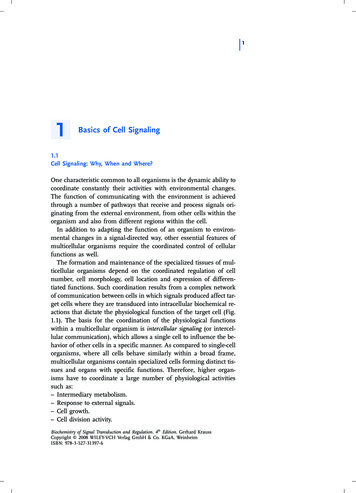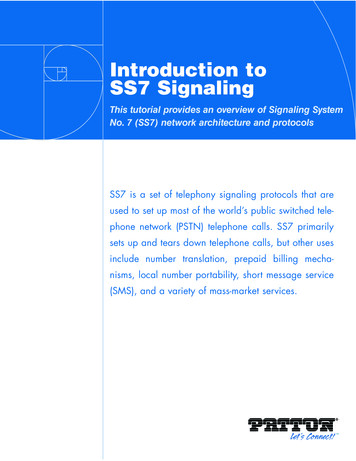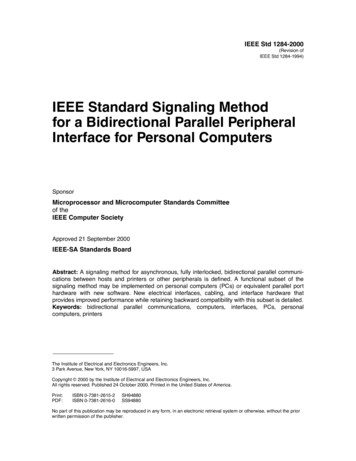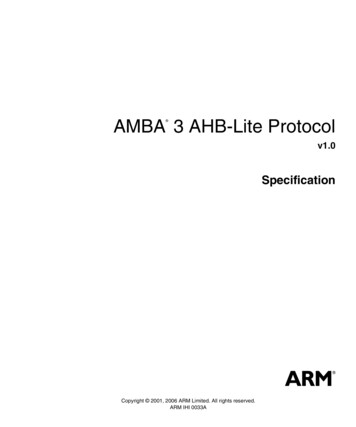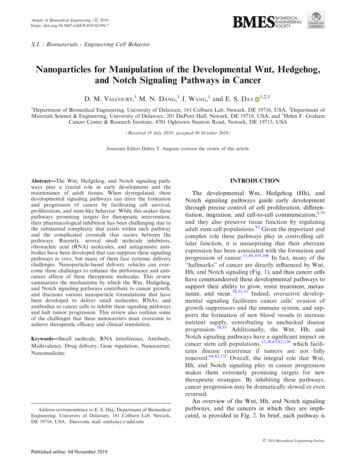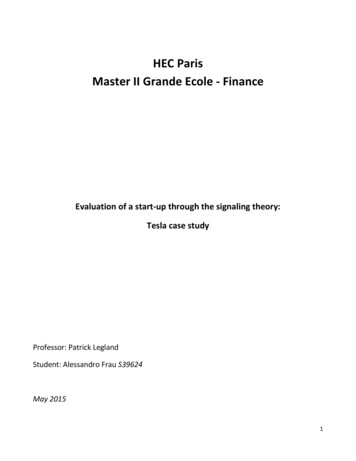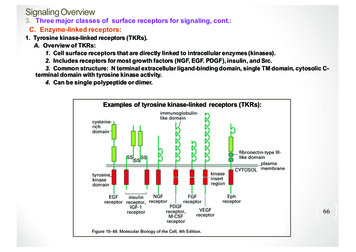
Transcription
Signaling Overview3. Three major classes of surface receptors for signaling, cont.:C. Enzyme-linked receptors:1. Tyrosine kinase-linked receptors (TKRs).A. Overview of TKRs:1. Cell surface receptors that are directly linked to intracellular enzymes (kinases).2. Includes receptors for most growth factors (NGF, EGF. PDGF), insulin, and Src.3. Common structure: N terminal extracellular ligand-binding domain, single TM domain, cytosolic Cterminal domain with tyrosine kinase activity.4. Can be single polypeptide or dimer.Examples of tyrosine kinase-linked receptors (TKRs):66
Signaling Overview3. Three major classes of surface receptors for signaling, cont.:C. Enzyme-linked receptors, cont.:Pabio 552, J. R. Lingappa4/27/061. Tyrosine kinase-linked receptors (TKRs)B. Mechanism of activation of TKRs:i. ligand binding induces receptor dimerization (receptor crosslinking).ii. dimerization leads to autophosphorylation of the receptor (cross-phosphorylation).iii. phosphorylation increases kinase activity & also creates specific new binding sites.iv. proteins that bind to these new binding sites transmit intracellular signals.67
Pabio 552, J. R. Lingappa4/27/06How receptor tyrosine kinases work together with monomeric GTPases:68
Signaling Overview3. Three major classes of surface receptors for signaling, cont.:C. Enzyme-linked receptors, cont.:1. Tyrosine kinase-linked receptors (TKRs)B. Mechanism of activation of TKRs:4/27/06v. example: Src homology 2 (SH2) domains on other proteins bind to phosphotyrosinecontaining regions of TKRs resulting in:a. localization of SH2-containing proteins at plasma membrane.b. association of SH2-containing proteins with other proteins.c. phosphorylation of SH2-containing proteins.d. activation of enzymatic activity of SH2-containing proteins.69From Janeway, Immunobiology, 5th edition
Signaling Overview3. Three major classes of surface receptors for signaling, cont.:C. Enzyme-linked receptors, cont.:1. Tyrosine kinase-linked receptors (TKRs)C. Different ways that TKRs can be activated:i. Ligand dimerizationii. Monomeric ligand binds to a crosslinking proteiniii. Clustered monomeric cell-surface ligand70
Signaling Overview3. Three major classes of surface receptorsfor signaling, cont.:C. Enzyme-linked receptors, cont.:A. Overview1. N-term. extracell. ligand-binding domain, transmembα helix,C-term. cytosolic domain2. Cytosolic domain has no catalytic (kinase) activity3. Acts in conjuction with a non-receptor tyrosine kinasethat is activated as a result of ligand binding.4. Activation is similar to that of RTKs: ligand bindingcauses cross phosphorylation of associatedtyrosine kinases that phosphorylate the receptor,providing phosphotyrosine binding sites forrecruitment of proteins with SH2 domains.Pabio 552, J. R. LingappaCytokine receptors, as well as T and B cellreceptors, stimulate tyrosine kinases that are noncovalently associated with receptor.4/27/062. TKs non-covalently associated withreceptor (includes cytokine receptors, T & Bcell receptors) NRTKsFrom Janeway, Immunobiology, 5th edition 71
Signaling Overview3. Three major classes of surface receptors for signaling, cont.:C. Enzyme-linked receptors, cont.:C. Receptors can be linked to or associatedwith other enzymes, besides TKs, i.e.Protein-tyrosine phosphatases (removephosphates, thereby terminate signals initiatedby protein-tyrosine kinases).Serine/ threonine kinases, i.e. TGF-βGuanylyl cyclasesPabio 552, J. R. Lingappa1. Src family protein kinases - important for Band T cell signaling2. Janus kinases (JAK) - universally requiredfor signaling from cytokine receptors.4/27/06B. Two kinds of kinases associate with NRTKs:From Janeway, Immunobiology, 5th edition 72From Janeway, Immunobiology, 5th edition
Enzyme-linkedReceptor (theLeptin receptor)JAK JanusKinaseSTAT SignalTransducerand Activatorof Transcription
University of Jordan The receptor exists as a homodimer (two identical parts) Leptin binds to the extracellular part of the receptor This causes activation of the intracellular associated januskinas 2 This causes phosphorylation of signal transducer and activatorof transcription (STAT) proteins This then activates the transcription of target genes andsynthesis of proteins JAK 2 phosphorylation also activates several other enzymesystems that mediate some of the more rapid effects of leptin74Enzyme-linked receptor(the leptin receptor)
University of Jordan75Tyrosine Kinase
University of Jordan76Tyrosine Kinase Receptors:
Tyrosine Kinase Insulin receptor consists of 2 units that dimerizewhen they bind with insulin. Autophosphorylation occurs, increasing tyrosinekinase activity. Activates signaling molecules.University of Jordan Insulin binds to ligand–binding site on plasma membrane,activating enzymatic site in the cytoplasm. Stimulate glycogen, fat and protein synthesis. Stimulate insertion of GLUT-4 carrier proteins.77
University of JordanTyrosine Kinase78
University of Jordan79The Insulin Receptor & Mechanismsof Insulin Action
University of Jordan80
University of Jordan81Insulin Action on Cells:
Signaling Overview4. Second Messengers: for Hormones thatcan’t cross PMcAMP production:Pabio 552, J. R. Lingappai. Production:ATP converted to cAMP by adenylate cyclase (a largemultipass TM protein)Degraded by cAMP phosphodiesteraseii. Action:a. cAMP-dependent protein kinase (protein kinase A(PKA)).PKA is a tetramer of catalytic and regulatory subunitscAMP binding leads to dissociation of regulatorysubunits and release of catalytic subunits which thenphosphorylate target proteins in cytoplasm:4/27/06A. cAMP:From Janeway, Immunobiology, 5th edition 82
Signaling Overview4. Second Messengers, cont.:A. cAMP, cont.iii. Action:b. PKA enters the nucleus and phosphorylates CREB (CRE binding protein), which binds tothe cAMP response element (CRE), a regulatory DNA sequence associated with specificgenes. This results in activation of transcription of those genes.iv. Rapid turn on and rapid turn off of cAMP and activation by cAMP :Question: what turns off proteins activated by protein kinases?v. Amplification of signal at each step of signaling pathway - characteristic feature of signaltransduction.83
Signaling Overview4. Second Messengers, cont.:A. cAMP, cont.:Summary of how cAMP activates transcription:vi. Regulation of adenylate cyclase:Receptors that cause increase in cAMP do soby activating Gs, a stimulatory proteinthat activates adenylyl cylase.Adenylyl cyclase is turned off by Gi, aninhibitory protein.vii. Pathogens alter cAMP production:Cholera toxin active subunit catalyzestransfer of ADP ribose from intracellularNAD to the asubunit of Gs, causing it tobe continuously active, stimulatingadenylyl cyclase indefinitely. Thiscauses ion channels that exportchloride to produce a net effux of Cland water, leading to severe diarrheacharacteristic of cholera.B. cGMP:1. produced from GTP by guanylyl cyclase;2. activates cGMP-dependent kinases orother targets3. example: G-prot. Coupled rhodopsinphotoreceptor in rod cells of retina84
Phosphorylatesenzymes within thecell to producehormone’s effects. Modulates activity ofenzymes present inthe cell. Alters metabolism ofthe cell. cAMP inactivated byphosphodiesterase. Hydrolyzes cAMPto inactivefragments.University of JordanAdenylate Cyclase-cAMP85
86University of Jordan
University of Jordan87G-Protein-coupled Receptors
Signaling OverviewPabio 552, J. R. Lingappa1. Overview: Phosphotidylinositol 4,5bisphosphate (PIP2) triggers a 2armed signaling pathwaya. PIP2 is a minor PL in inner leaflet ofPM bilayer that is produced byphosphorylation of phosphatidylinositol and is involved in signalingb. Ligand binding to certain receptorsstimulates PIP2 hydrolysis byphospholipase C (PLC)c. This produces diacylglycerol (DAG)and inositol 1,4,5-phosphate (IP3),both of which are 2nd messengersd. PIP2 hydrolysis is activated by bothGPRs and TKRs via different formsof PLCe. PLC-β is stimulated by Gq proteinswhile PLC-γ has SH2 domains thatallow binding to activated tyrosinekinases4/27/064. Second Messengers, cont.:C.IP3 and DAG:88
University of Jordan89PhospholipaseC-Ca2
Signaling Overview4. Second Messengers, cont.:C. DAG and IP3, cont.:2. DAG: Remains associated with the PMa. Stimulates the Ca 2-dependent protein kinase C signaling pathway, which activates othertargets including the MAP kinase cascade (see below)b. Can also be cleaved to form another messenger, eicosanoids, which include prostaglandinsc. Tumor producing phorbol esters mimic DAG and thereby stimulate protein kinase C3. IP3: Small polar molecule released into cytosola. Stimulates Ca 2 release from intracellular stores. Question: where are these?b. Elevated Ca 2 alters activities of target proteins including kinases & phosphatases90
PLC- signaling pathwayPKCPhosphorylatesmany substrates,can activatekinase pathway,gene regulation
Signaling Overview4. Second Messengers, cont.:D. Ca 2 also acts as a second messengerCa 2 concentration kept low (10-7 M), rising locally due to transient signalingEffects of intracellular Ca 2 are mediated by the Ca 2 binding protein calmodulin.Ca 2 /calmodulin binds to target proteins, including protein kinases (Ca 2calmodulin-dependentkinases; CaM-kinases), adenylyl cyclases, and phosphodiesterases, causing change inconformation and activation of these proteins.92
University of Jordan93Epinephrine Can Act Through Two 2ndMessenger Systems
Ca2 diffuses into thecytoplasm. Ca2 binds tocalmodulin. Calmodulin activatesspecific protein kinaseenzymes. Alters themetabolism of thecell, producing thehormone’s effects.University of Jordan2 Ca - Calmodulin (continued)94
95Calmodulin (continued)University of Jordan2 Ca -
Guanylate cyclase (GC) receptorMembrane receptor –ANPSoluble receptor – NO, CO
Pabio 552, J. R. Lingappa4/27/06NO signaling97
Signaling Overview4. Second Messengers, cont.:E. PIP3:PIP2 phosphorylated by PI 3-kinase, resulting in PIP3, which is also a 2nd messenger.PI 3-kinase can be activated by GPRs or TKRs.One target of PIP3 is a protein-serine/threonine kinase called Akt, or protein kinase B,which becomes activated by a kinase called PDK1.PIP3 binds to Akt at the pleckstrin homology domain.Activation of Akt leads to regulation of target molecules, including BAD, which is pro-apoptotic andbecomes inactivated by phosphorylation.98
Signaling Overview5. Signaling Cascades, cont.:5 downstream kinases activated by different signaling cascades99
100Pabio 552, J. R. Lingappa4/27/06
University of Jordan101§ Receptors superfamilies:§Ionotropic receptors (ligand-gated channels)§Metabotropic receptors (G protein-coupled receptors)§Tyrosine KinaseAlmost all neurotransmitters discovered so far have morethan one kind of receptor -- called receptor subtypes.
Transmitter synthesized and stored2.Action Potential3.Depolarization: open voltage-gated Ca2 channels4.Ca2 enter cell5.Ca2 causes vesicles to fuse withmembrane6.Neurotransmitter released (exocytosis)7.Neurotransmitter binds to postsynapticreceptors8.Opening or closing of postsynapticchannels9.Postsynaptic current excites or inhibitspostsynaptic potential to changeexcitability of cell10.Retrieval of vesicles from plasmamembrane (endocytosis)University of Jordan1.102§ Neurotransmitter Release: exocytosis and endocytosis
Reuptake bytransporters(glial cells)103Transmitter Inactivation:reuptake and enzymatic breakdownEnzymaticbreakdownNeurotransmitter can be recycled in presynaptic terminalor can be broken down by enzymes within the cellUniversity of Jordan§
NT – Receptor BindingReceptors are large, dynamic proteins thatexist along and within the cell membrane.Ionotropic receptors: NT binding results in direct opening orclosure of specific ion channelsMetabotropic receptors: binding of NT initiates a sequence ofinternal molecular events which in turn open specific ionchannelsUniversity of JordanTwo Types of Post synaptic Receptors:104Dynamic – they can increase in number and avidity for theirneurotransmitter according to circumstances.
University of Jordan105NT binding - MembranePotential Response
Ionotropic ReceptorsUniversity of Jordan1. Each is made of severalsubunits (together form thecomplete receptor)2. At center of receptors ischannel or pore to allowflow of ions3. At rest - receptor channelsare closed4. When neurotransmitterbinds -- channelimmediately opens5. When ligand leaves bindingsite -- channel quickly closes106Work very fast; important role infast neurotransmission
Metabotropic Receptors University of Jordan1. Each is made ofseveraltransmembraneregions2. Stimulate or inhibitthe opening of ionchannels in the cellmembrane3. Work more slowlythan ionotrophicreceptors but lastslonger107Work by activating otherproteins called Gproteins
*Second messenger:effector enzymeUniversity of Jordan1. Stimulate or inhibitcertain effectorenzymes2. Most effectorenzymes controlledby G proteins areinvolved in synthesisof secondmessengers.*First messenger:ligand.108Metabotropic Receptors
University of JordanCan work by affecting:NT production, no.synapses formed,sensitivity of receptors,or expression of genes(long term effects).Can result inamplification interconnections.109Second messengers: ActivateProtein Kinases
Metabotropic ReceptorsUniversity of Jordan1. Though it takes longer forpostsynapic cell to respond,response is somewhat longerlasting2. Comprise a single protein subunit,winding back-and-forth throughcell membrane seven times(transmembrane domains)3. They do not possess a channel orpore110Work more slowly than ionotropicreceptors
University of Jordan111
University of Jordan112
Hormones That Bind to Nuclear ReceptorProteins Lipophilic steroid andthyroid hormones areattached to plasmacarrier proteins. Hormones dissociate fromcarrier proteins to passthrough lipid component ofthe target plasma membrane. Receptors for thelipophilic hormones areknown as nuclearhormone receptors.
Nuclear Hormone Receptors Each nuclear hormone receptor has 2 regions: A ligand (hormone)-binding domain. DNA-binding domain. Receptor must be activated by binding to hormonebefore binding to specific region of DNA called HRE(hormone responsive element). Located adjacent to gene that will be transcribed.University of Jordan Messenger RNA directs synthesis of specific enzyme proteins thatchange metabolism.114 Steroid receptors are located in cytoplasm and in thenucleus. Function within cell to activate genetic transcription.
Cytoplasmic receptorbinds to steroid hormone. Translocates to nucleus. DNA-binding domainbinds to specific HRE ofthe DNA. Dimerization occurs. Process of 2 receptorunits coming together atthe 2 half-sites. Stimulates transcription ofparticular genes.University of JordanMechanisms of Steroid Hormone Action115
Mechanism of Thyroid Hormone Action T4 passes into cytoplasm and isconverted to T3. Receptor proteins located innucleus. T3 binds to ligand-bindingdomain. Other half-site is vitamin Aderivative (9-cis-retinoic)acid. DNA-binding domaincan then bind to the halfsite of the HRE. Two partners can bind to theDNA to activate HRE. Stimulate transcriptionof genes.
University of Jordan117Steroid & Thyroid Hormones - Mechanism ofAction
University of Jordan118Actions of Thyroid Hormones
Determinants of Free Hormone ptorHormonedegradationBiologicaleffectsUniversity of Jordan119Carrier-boundhormone
Correlation of Plasma Half-Life & Metabolic Clearance of Hormones with Degree of ProteinBindingProteinPlasma half-lifebinding (%)Metabolic ne99.9799.76 days1 0 min85 min25 c hormonelittlelittlelittle50 min8 min8 min508006000.718University of Jordan 120Hormone
Circulating Transport ProteinsPrinciple HormoneTransported121SpecificCortisol, aldosteroneCorticosteroid binding globulin(CBG, transcortin)Thyroxine binding globulin (TBG) Thyroxine, triiodothyronineTestosterone, estrogenSex hormone-binding globulin(SHBG)NonspecificAlbuminTransthyretin (prealbumin)Most steroids, thyroxine,triiodothyronineThyroxine, some steroidsUniversity of JordanTransport Protein
University of Jordan122
University of Jordan123
Intracellular molecule(second messengers)biological effectSignaltransductionUniversity of JordanReceptor of target cell124Signaling molecule(hormones)
University of JordanThird messengers are the molecules which transmit messagefrom outside to inside of nucleous or from inside to outside ofnucleous, also called DNA binding protein.125Third messengers:
ExtracellularmoleculesEffect armoleculesHormones, cytokinesAmino acid derivatives:CatecholaminesFatty acid derivatives:ProstaglandinsSteroid hormones,Thyroxine, VD3cAMP, cGMP, IP3, DG, Ca2 University of JordanEffect bymembranereceptors126Proteins and peptides:
From Janeway, Immunobiology, 5th edition. Signaling Overview 3. Three major classes of surface receptors for signaling, cont.: C. Enzyme-linked receptors, cont.: 1. Tyrosine kinase -linked receptors (TKRs) C. Different ways that TKRs can be activated: i. Ligand dimerization ii. Monomeric ligand binds to a crosslinking protein
